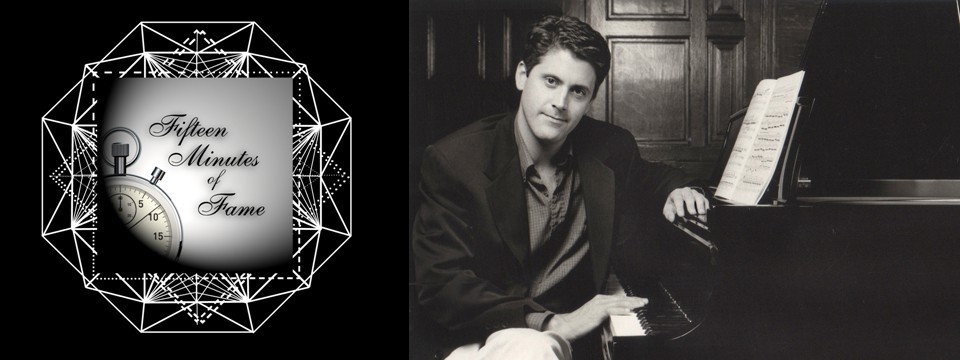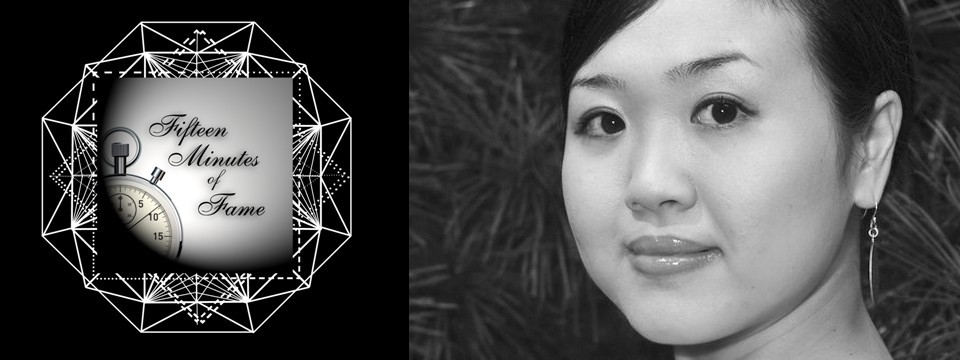Fifteen-Minutes-of-Fame Into the Chaotic Dreams with Yumi Suehiro
Composer's Voice
OCTOBER 24, 2015 8:00 PM
SYMPHONY SPACE
Leonard Nimoy Thalia
2537 Broadway, New York, NY 10025
Fifteen-Minutes-of-Fame is 15 one-minute works by different composers written for a specific performer or ensemble.
The theme of this Fifteen-Minutes-of-Fame is “Into the Chaotic Dreams” The collections of 15 works seeks an answer to an imaginary question: How can one define oneself in the surreal world?
Yumi Suehiro, piano
Pianist Yumi Suehiro began studying both piano and marimba at an early age. In her native Japan, Ms. Suehiro won numerous competitions, including the top prize at the Kobe International Competition as the youngest winner. As a pianist, she has performed at New York City’s Weill Recital Hall (Carnegie) as an AMTL Audition Winner, and at Steinway Hall, presented by the Amati Music Festival. She also was the featured marimba player in Latin percussionist Victor Rendon's recording of “Fiesta Percussiva”. Ms. Suehiro graduated from Lehman College (CUNY) and the Manhattan School of Music. While at Manhattan, she won second prize in the school’s 2010 piano concerto competition, and in 2011 was chosen to perform Richard Wilson’s “Flashback” for Pierre Aimard’s master class. Her teachers have included Morris Lang, John Corigliano, Peter Vinograde, and Zenon Fishbein.
Chaotic Dream
Saman Shahi
Saman Shahi is a professional musician in Toronto. His music has been read and performed by many ensembles and renowned performers across Canada ( National Ballet of Canada), United States as well as France, Germany and Malaysia. His Music has also been broadcast on BBC Farsi and CBC.
This short piece uses perfect intervals to create dissonance, that is perfect, diminished and augmented 4th and 5ths. The piece has a sense of terror in it, even when it slows down in the middle. Charles Ives and Vincent Persichetti were huge influences on the harmonic language of this piece.
Estudio sobre líneas
Francisco del Pino
A former student of Fernando Maglia and Gerardo Gandini, Francisco del Pino (*1980) is a composer born in Buenos Aires, Argentina. His work spans from solo to symphonic music and has been awarded several national and international prizes.
In this short piece, the instrumental writing is constrained to the extent of using the piano only in a monophonic manner. The pitch material is entirely derived from the first seven notes of the piano part of Schoenberg’s Pierrot Lunaire, which are directly quoted towards the end of the work.
Episode XVII
Anthony Donofrio
Anthony Donofrio currently teaches composition, theory, and new music at the University of Nebraska Kearney. His artistic influences include the relationship between literary structure and music, evening-length pieces, and the music of Morton Feldman. More information can be found at www.donofrio-music.com.
When prompted by this call to create a "daring and challenging work," I wanted to make a piece that went against the usual ideas of what is "daring and challenging." s of the piece lies in its simplicity, as both the left and right hands play the same rhythm throughout and only in dyads. Martin Watt is a South African composer, currently lecturing in musical analysis, composition and orchestration at the South African College of Music in Cape Town. He has composed over 50 works and his music has been performed, recorded and broadcast in many European countries, The US and The East.
Water Crystals
Mathieu Daniel Polak
Mathieu Daniël Polak (born 1972) obtained two Master Degrees in Composition namely at the Lemmens Institute in Leuven (Belgium) and at the Utrecht School of Arts in Utrecht (The Netherlands). At both schools he studied with Dr. Jeroen D’hoe. Moreover, Mathieu studied carillon at the Netherlands Carillon School in Amersfoort.
The six corners of the water crystal are symbolized by the use of the whole – tone scale. The intervals used, are fifths, seconds and octave transformations. The resulting number 5/2/8 is pointing to the final note of the composition, C2, which (in pure intonation) has a frequency of 528
Like Clockwork
James Gaddas
James Gaddas is an emerging composer based in Cardiff (UK). They attended Cardiff University, graduating in 2015, having studied composition with Arlene Sierra.
Like Clockwork is a short work for solo piano which seeks to summon a vision of the inner workings of a clock. Following a quick wind up, the clock initially keeps time before beginning to slip in a variety of ways.
Prelude (Taken By Storm)
Gabriele Toia
Italian pianist, harpsichordist and composer. He graduated from the Conservatory of Milan. His music has been performed in Italy, Switzerland, Greece, Holland, USA, New Zealand and Australia. He has recorded contemporary and ancient music for Ducale, MDS Records Zurich and participated in broadcasts of Italian and Swiss national radios.
It's a sort of paradiddle piece for drums adapted to the piano. The title alludes to the frantic search for a tonal center.
Prelude Y
Steven Aprahamian
Steven Aprahamian has composed music for theater productions, concert performances, and art installations throughout the United States and abroad. Born in Manhattan, he graduated from Rutgers College (English, honors) and later studied composition with Charles Wuorinen and Charles Fussel. His latest musical theater piece is The Fountain of Youth (foymusical.com).
Prelude Y, composed for Yumi Suehiro, demonstrates the composer’s interest in post-romantic harmony, as well as sparse textures and syncopated rhythms that propel ethnic and popular music.
Anche il vento
Luca Vanneschi
Luca Vanneschi’s music was awarded prizes in more than twenty International competitions and it has been performed by some of the more qualified musicians all over the world. Hans Werner Henze said about his music: “… it is an intelligent, non conformist, elegant and full of grace music.”
After having burnt each evocative and narrative aspect, the Anche il vento musical structure gives a concrete form to a space lacking in time, where the pure sound is the unique presence and the unique voice.
Capriccio
Martin Watt
Martin Watt is a South African composer, currently lecturing in musical analysis, composition and orchestration at the South African College of Music in Cape Town. He has composed over 50 works and his music has been performed, recorded and broadcast in many European countries, The US and The East.
This short piano piece is built from small melodic sells and when woven together, create interesting melodic lines. The effectiveness of the piece lies in its simplicity, as both the left and right hands play the same rhythm throughout and only in dyads.
Will-o'-the-wisp
Tomàs Peire
Born in Barcelona, Tomàs Peire is a music composer based in Los Angeles. He studied composition in Barcelona, Helsinki at Sibelius Academy, and New York, where he earned a Master’s degree in Composition (NYU). He writes both concert and film music and is pursuing a PhD in Composition at UCLA.
For a long time I’ve been fascinated by this beautiful phenomena that triggers the imagination and has generated tales, legends and superstitions. This project is the perfect excuse for that piece, a fleeting interpretation on Will-o’-the-wisp that tries to capture its magic instability by a trembling and flickering musical device.
ART NO WAR 5
Luigi Morleo
Luigi Morleo (born 16 November 1970 in Mesagne, Province of Brindisi) is an Italian percussionist and composer of contemporary music, who lives in Bari and teaches in Bari at the Niccolò Piccinni Conservatory. He appears in varied musical and artistic styles like rock-cross-over, folk-popular, jazz and DJ; however actors,
Sottolineare
Jean-Patrick Besingrand
Jean-Patrick Besingrand is a French composer living in the US. He holds a Master in Music and Conservatory prizes in Composition, Soundpainting, Musical analysis, Harmony, Counterpoint, and Fugue. He is working on his thesis at the Sorbonne, and studies composition at CUNY the Graduate Center.
Sottolineare is a piece constructed around pivot notes influenced by Indian music, and a percussive effect. These two polarities interact with each other along a miniature arch form that has the note F in the central pivot with the percussive effect of the prepared piano in Bb.
Ragtime Two Step
Edward Strauman
Edward Strauman, a Yamaha Artist/Educator and a Eubie and Marion Blake Scholar, earned his Ph.D. in music composition from New York University. He studied composition with David Berger, Edward Green, Justin Dello Joio and Deniz Hughes. Dr. Strauman is an Associate Professor of Music at Chestnut Hill College in Philadelphia.
Ragtime Two Step is intended as a frolicking dance piece reminiscent of the Ragtime Era. Melodically and harmonically, the work juxtaposes black and white keys, as well as rhythmic foot stomping and knuckle knocking.
Prelude IV
Fabian Beltran
Fabian Beltran was originally born in Bogota, Colombia and recently received a B.A in Music Composition from the University of Texas. As an undergraduate student, he was the recipient of multiple awards. In the Fall of 2015, Fabian will begin his M.M composition studies at the Manhattan School of Music.
Prelude IV consist of a single frantic monophonic idea with no tonal center. This motive is primarily built around triads and it quickly encompasses the entire range of the piano. In addition, the motive contains multiple contour and articulation accents that generate syncopations and meter ambiguity.
After Bartok
Steven Harry Markowitz
Steven attended Dick Grove school of music in Studio City California. He enjoys improvising at the keyboard employing stylings which blend classical and jazz influences. His compositions have been world premiered in Romania, New York and Boston.
Composed in a single sitting, this piece has a primitive expressionistic feel reminiscent of Bela Bartok.


 1
1 2
2